Page 5 of 104
Panic AlarmEngine Oil
Engine CoolantEngine Coolant
Temperature
Do Not Open When HotBattery
Avoid Smoking, Flames,
or SparksBattery Acid
Explosive GasFan Warning
Power Steering FluidMaintain Correct Fluid
LevelMAX
MIN
Emission SystemEngine Air Filter
Passenger Compartment
Air FilterJack
Check fuel cap
Introduction
5
Page 60 of 104
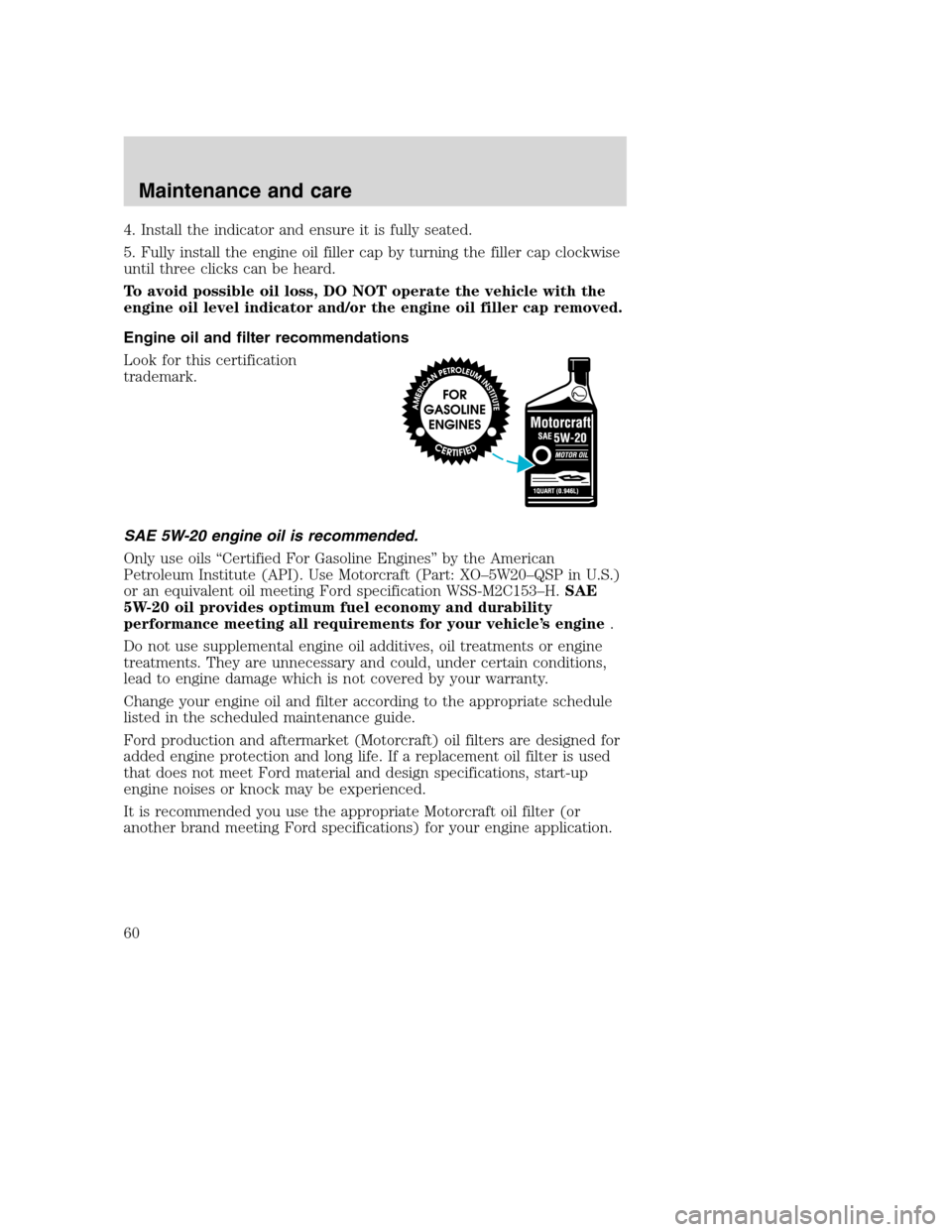
4. Install the indicator and ensure it is fully seated.
5. Fully install the engine oil filler cap by turning the filler cap clockwise
until three clicks can be heard.
To avoid possible oil loss, DO NOT operate the vehicle with the
engine oil level indicator and/or the engine oil filler cap removed.
Engine oil and filter recommendations
Look for this certification
trademark.
SAE 5W-20 engine oil is recommended.
Only use oils “Certified For Gasoline Engines” by the American
Petroleum Institute (API). Use Motorcraft (Part: XO–5W20–QSP in U.S.)
or an equivalent oil meeting Ford specification WSS-M2C153–H.SAE
5W-20 oil provides optimum fuel economy and durability
performance meeting all requirements for your vehicle’s engine.
Do not use supplemental engine oil additives, oil treatments or engine
treatments. They are unnecessary and could, under certain conditions,
lead to engine damage which is not covered by your warranty.
Change your engine oil and filter according to the appropriate schedule
listed in the scheduled maintenance guide.
Ford production and aftermarket (Motorcraft) oil filters are designed for
added engine protection and long life. If a replacement oil filter is used
that does not meet Ford material and design specifications, start-up
engine noises or knock may be experienced.
It is recommended you use the appropriate Motorcraft oil filter (or
another brand meeting Ford specifications) for your engine application.
Maintenance and care
60
Page 87 of 104
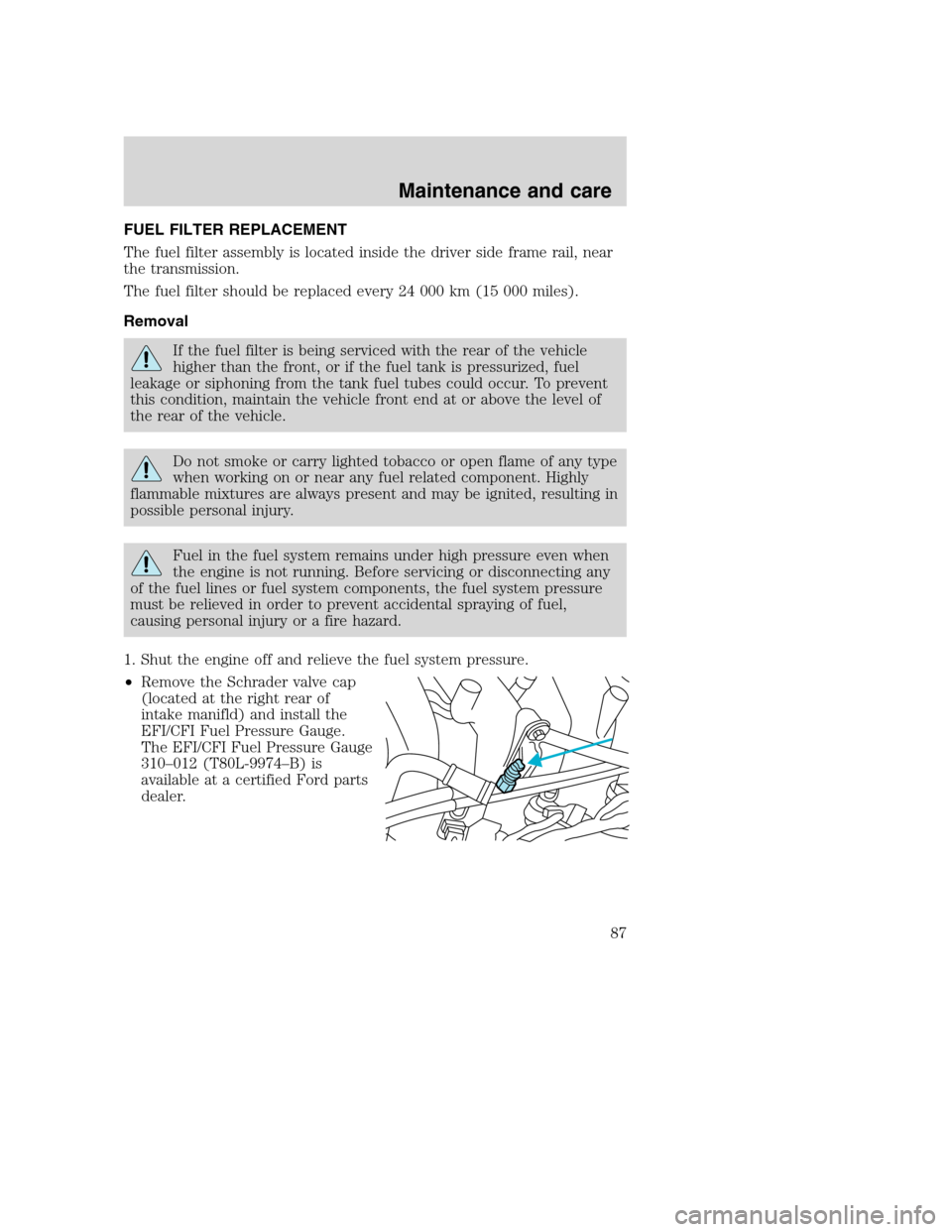
FUEL FILTER REPLACEMENT
The fuel filter assembly is located inside the driver side frame rail, near
the transmission.
The fuel filter should be replaced every 24 000 km (15 000 miles).
Removal
If the fuel filter is being serviced with the rear of the vehicle
higher than the front, or if the fuel tank is pressurized, fuel
leakage or siphoning from the tank fuel tubes could occur. To prevent
this condition, maintain the vehicle front end at or above the level of
the rear of the vehicle.
Do not smoke or carry lighted tobacco or open flame of any type
when working on or near any fuel related component. Highly
flammable mixtures are always present and may be ignited, resulting in
possible personal injury.
Fuel in the fuel system remains under high pressure even when
the engine is not running. Before servicing or disconnecting any
of the fuel lines or fuel system components, the fuel system pressure
must be relieved in order to prevent accidental spraying of fuel,
causing personal injury or a fire hazard.
1. Shut the engine off and relieve the fuel system pressure.
•Remove the Schrader valve cap
(located at the right rear of
intake manifld) and install the
EFI/CFI Fuel Pressure Gauge.
The EFI/CFI Fuel Pressure Gauge
310–012 (T80L-9974–B) is
available at a certified Ford parts
dealer.
Maintenance and care
87
Page 88 of 104
•Open the manual valve slowly on
the EFI/CFI Fuel Pressure Gauge
and relieve the fuel pressure. This
will drain some fuel out of the
system; place the fuel in a
suitable container.
2. Use the fuel line disconnect tool
to disconnect the fuel lines from the
fuel filter. The Fuel Line Disconnect
Tool 310–S039 (T90T-9550–S) is
available at a certified Ford parts
dealer.
•Disconnect the safety clip from
the male hose.
•Install the fuel line disconnect
tool and push into the fitting.
•Separate the fittings. Clean the
fittings and inspect the fittings for
damage.
Maintenance and care
88
Page 89 of 104
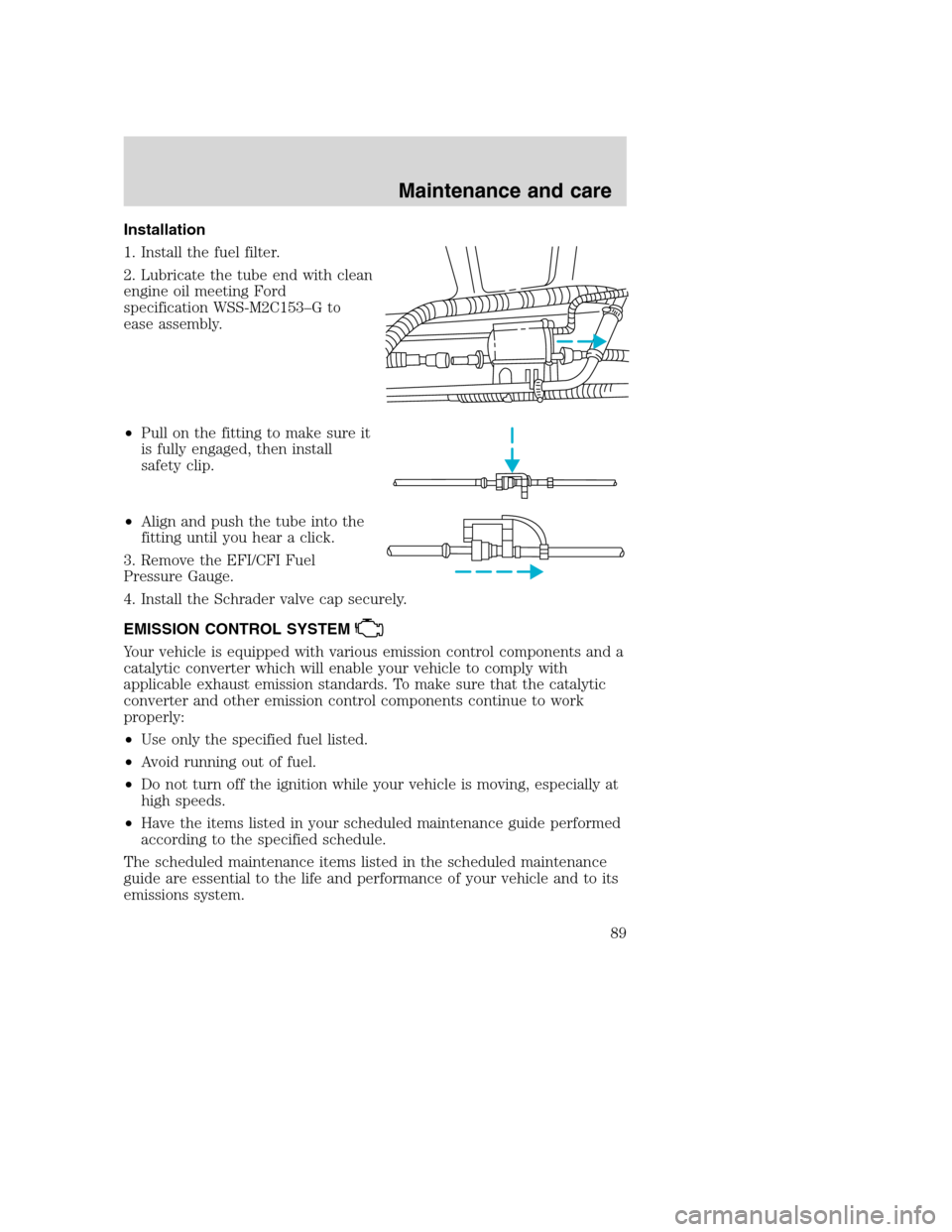
Installation
1. Install the fuel filter.
2. Lubricate the tube end with clean
engine oil meeting Ford
specification WSS-M2C153–G to
ease assembly.
•Pull on the fitting to make sure it
is fully engaged, then install
safety clip.
•Align and push the tube into the
fitting until you hear a click.
3. Remove the EFI/CFI Fuel
Pressure Gauge.
4. Install the Schrader valve cap securely.
EMISSION CONTROL SYSTEM
Your vehicle is equipped with various emission control components and a
catalytic converter which will enable your vehicle to comply with
applicable exhaust emission standards. To make sure that the catalytic
converter and other emission control components continue to work
properly:
•Use only the specified fuel listed.
•Avoid running out of fuel.
•Do not turn off the ignition while your vehicle is moving, especially at
high speeds.
•Have the items listed in your scheduled maintenance guide performed
according to the specified schedule.
The scheduled maintenance items listed in the scheduled maintenance
guide are essential to the life and performance of your vehicle and to its
emissions system.
Maintenance and care
89
Page 93 of 104
MOTORCRAFT PART NUMBERS
Component 6.8L V10 engine
Air filter element FA-1634
Battery BXT-65-750
Fuel filter FG-986B
Oil filter FL-820-S
PCV valve EV-233
Spark plugs* AWSF-22E
*Refer to Vehicle Emissions Control Information (VECI) decal for spark
plug gap information.
Capacities and specifications
93
Page 94 of 104
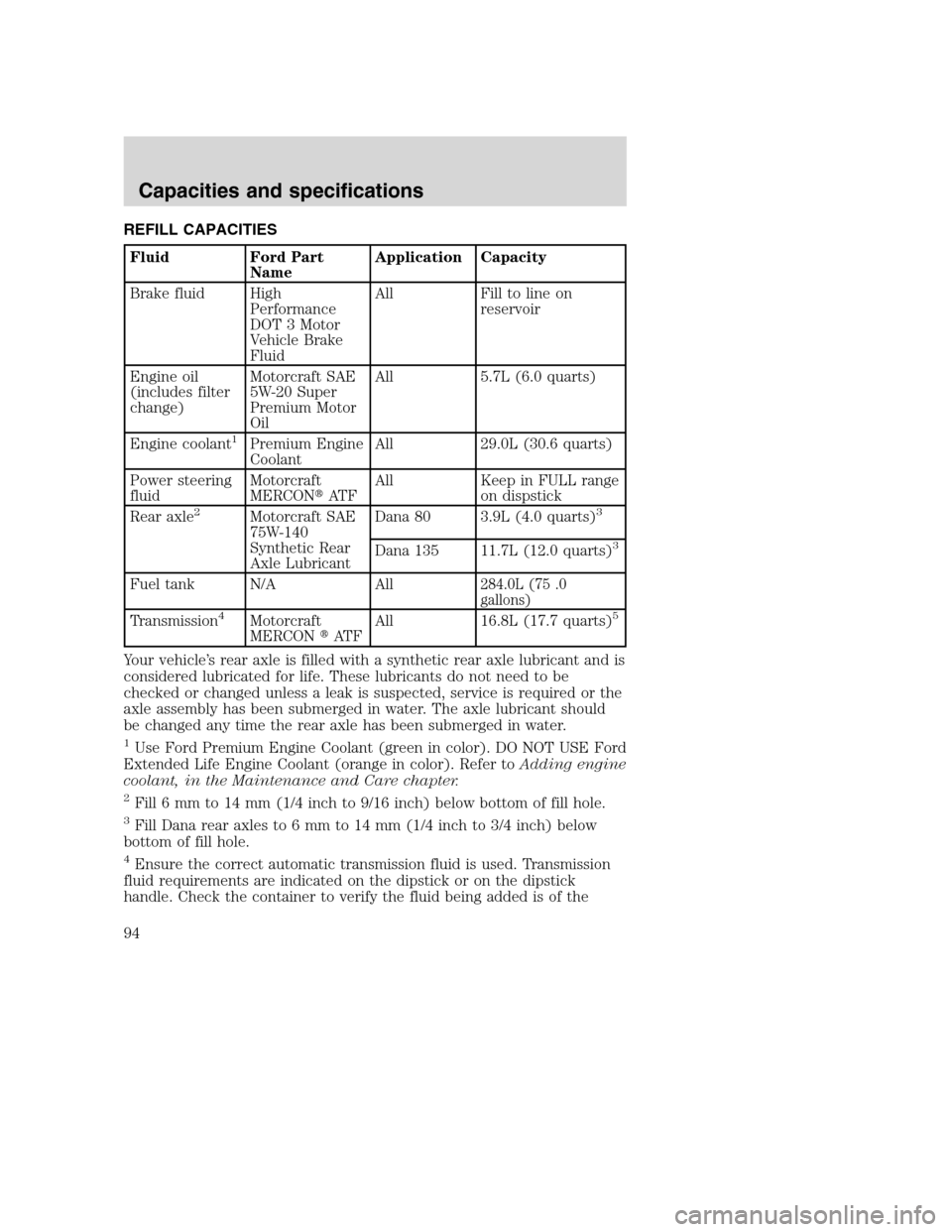
REFILL CAPACITIES
Fluid Ford Part
NameApplication Capacity
Brake fluid High
Performance
DOT 3 Motor
Vehicle Brake
FluidAll Fill to line on
reservoir
Engine oil
(includes filter
change)Motorcraft SAE
5W-20 Super
Premium Motor
OilAll 5.7L (6.0 quarts)
Engine coolant
1Premium Engine
CoolantAll 29.0L (30.6 quarts)
Power steering
fluidMotorcraft
MERCON�AT FAll Keep in FULL range
on dispstick
Rear axle
2Motorcraft SAE
75W-140
Synthetic Rear
Axle LubricantDana 80 3.9L (4.0 quarts)3
Dana 135 11.7L (12.0 quarts)3
Fuel tank N/A All284.0L (75 .0
gallons)
Transmission4Motorcraft
MERCON�AT FAll 16.8L (17.7 quarts)5
Your vehicle’s rear axle is filled with a synthetic rear axle lubricant and is
considered lubricated for life. These lubricants do not need to be
checked or changed unless a leak is suspected, service is required or the
axle assembly has been submerged in water. The axle lubricant should
be changed any time the rear axle has been submerged in water.
1Use Ford Premium Engine Coolant (green in color). DO NOT USE Ford
Extended Life Engine Coolant (orange in color). Refer toAdding engine
coolant, in the Maintenance and Care chapter.
2Fill 6 mm to 14 mm (1/4 inch to 9/16 inch) below bottom of fill hole.
3Fill Dana rear axles to 6 mm to 14 mm (1/4 inch to 3/4 inch) below
bottom of fill hole.
4Ensure the correct automatic transmission fluid is used. Transmission
fluid requirements are indicated on the dipstick or on the dipstick
handle. Check the container to verify the fluid being added is of the
Capacities and specifications
94
Page 101 of 104
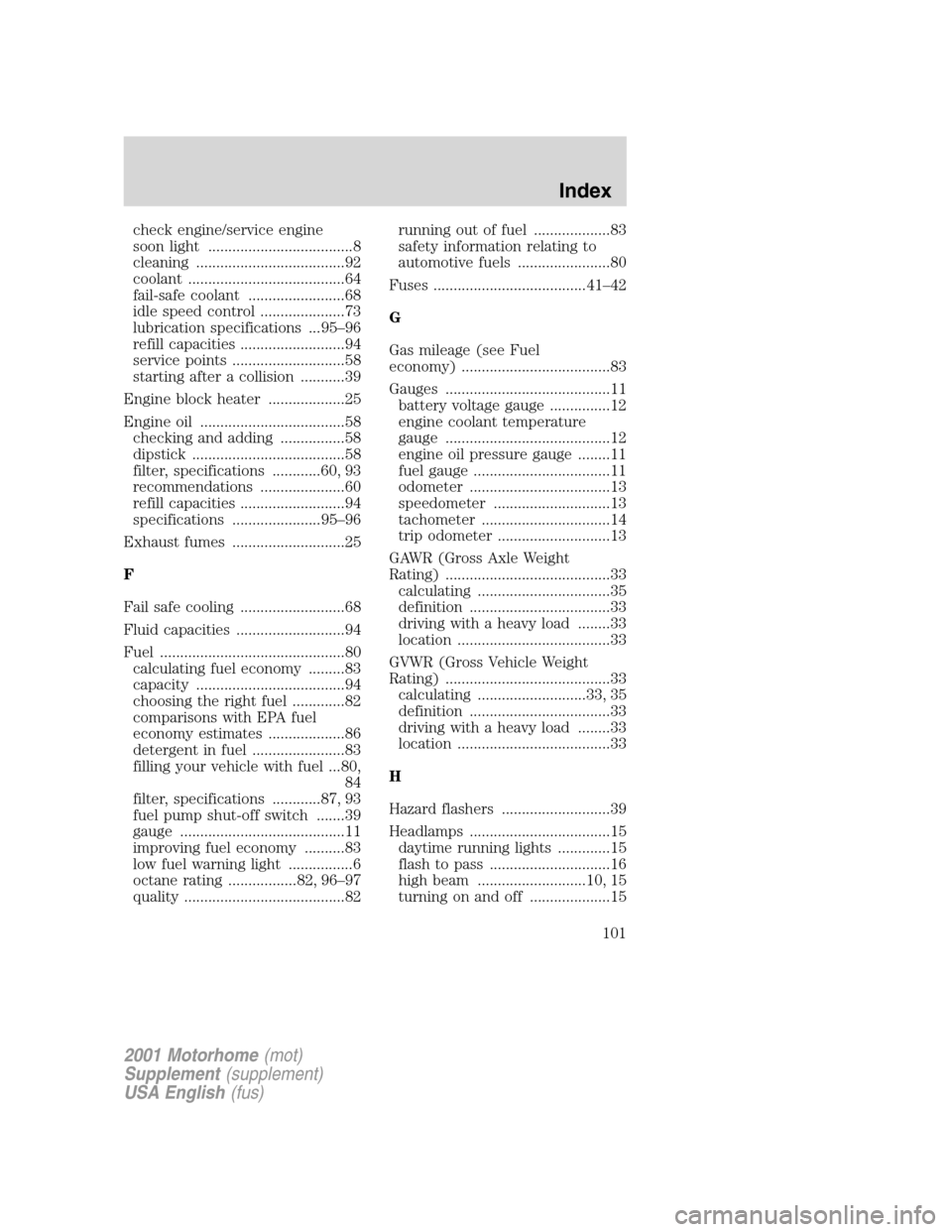
check engine/service engine
soon light ....................................8
cleaning .....................................92
coolant .......................................64
fail-safe coolant ........................68
idle speed control .....................73
lubrication specifications ...95–96
refill capacities ..........................94
service points ............................58
starting after a collision ...........39
Engine block heater ...................25
Engine oil ....................................58
checking and adding ................58
dipstick ......................................58
filter, specifications ............60, 93
recommendations .....................60
refill capacities ..........................94
specifications ......................95–96
Exhaust fumes ............................25
F
Fail safe cooling ..........................68
Fluid capacities ...........................94
Fuel ..............................................80
calculating fuel economy .........83
capacity .....................................94
choosing the right fuel .............82
comparisons with EPA fuel
economy estimates ...................86
detergent in fuel .......................83
filling your vehicle with fuel ...80,
84
filter, specifications ............87, 93
fuel pump shut-off switch .......39
gauge .........................................11
improving fuel economy ..........83
low fuel warning light ................6
octane rating .................82, 96–97
quality ........................................82running out of fuel ...................83
safety information relating to
automotive fuels .......................80
Fuses ......................................41–42
G
Gas mileage (see Fuel
economy) .....................................83
Gauges .........................................11
battery voltage gauge ...............12
engine coolant temperature
gauge .........................................12
engine oil pressure gauge ........11
fuel gauge ..................................11
odometer ...................................13
speedometer .............................13
tachometer ................................14
trip odometer ............................13
GAWR (Gross Axle Weight
Rating) .........................................33
calculating .................................35
definition ...................................33
driving with a heavy load ........33
location ......................................33
GVWR (Gross Vehicle Weight
Rating) .........................................33
calculating ...........................33, 35
definition ...................................33
driving with a heavy load ........33
location ......................................33
H
Hazard flashers ...........................39
Headlamps ...................................15
daytime running lights .............15
flash to pass ..............................16
high beam ...........................10, 15
turning on and off ....................15
2001 Motorhome(mot)
Supplement(supplement)
USA English(fus)
Index
101